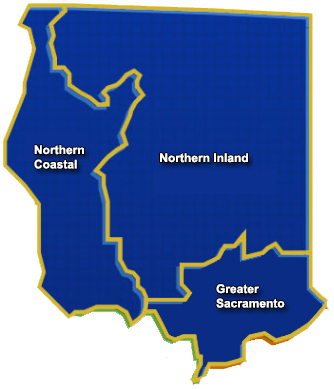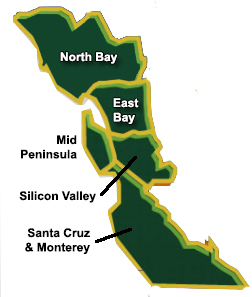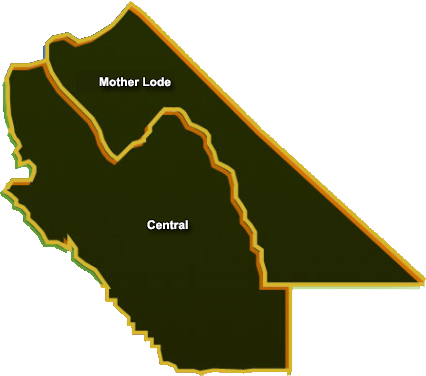
Our Institutions
Our member colleges are spread across 8 unique regions. Select a region below to learn more about their leadership, priorities, goals, and the community colleges that make up each region.

Discover Our State’s Unique Regions
-
NORTH/FAR NORTH
-
SAN FRANCISCO BAY AREA
-
CENTRAL VALLEY AND MOTHER LODE
-
SOUTH CENTRAL COAST
-
LOS ANGELES
-
ORANGE COUNTY
-
INLAND EMPIRE DESERT
-
SAN DIEGO/IMPERIAL
North / Far North Region

Executive Director:
Blaine Smith
northstatecareers.org
There are 15 colleges in the North/Far North Region spreading their influence from Woodland at their southern end and all the way north to the Oregon border. Colleges in this region serve a mostly rural student population, and have large successful programs focused on Agriculture, Forestry, and Construction trades among others.
Priority Sectors
- Advanced Manufacturing
- Advanced Transportation & Logistics
- Agriculture, Water & Environmental Technologies (AWET)
- Business & Entrepreneurship
- Education & Human Development
- Energy, Construction & Utilities
- Health, Information & Communications Technologies/Digital Media (ICT/Digital Media)
- Life Sciences & Biotechnology
- Public Safety & Government
- Retail, Hospitality & Tourism
STRONG WORKFORCE REGIONAL PLAN – OVERARCHING GOALS
Vision for Success Goals
- Increase number of students who acquire associate
- degrees, credentials, certificates, or specific skill sets that prepare them for an in-demand job
- Increase number of students transferring to a UC or CSU system
- Decrease the average number of units accumulated by community college students earning associate degrees
- Increase the percent of exiting CTE students who report being employed in their field of study
- Reduce equity gaps across all measures through faster improvements among traditionally underrepresented student groups
- Reduce equity gaps across all measures through faster improvements among traditionally underrepresented student groups
NFN Regional Goals
- Improve coordination of workforce training
- Improve responsiveness to employers
- Increase equitable student completions
- Further organizational effectiveness
Colleges in this Region
San Francisco Bay Area Region

Co-Chair:
Rock Pfotenhauer
831.212.7207
Co-Chair:
Kit O’Doherty
650.274.5236
There are 28 colleges in the San Francisco Bay Area Region. This region may not have cover the largest land area but it serves more students than nearly all the others. Colleges in this region are working to build pathways for bay area students to advance in business & entrepreneurship, biotech, health, and global trade among many other areas.
Priority Sectors
- Advanced Manufacturing
- Advanced Transportation & Logistics
- Health
- Information & Communication Technologies (ICT)/Digital Media
- Public Safely
BAY AREA REGIONAL WORKFORCE PLAN – OVERARCHING GOALS
Goal A: Provide pathways that enable all Bay Area students to find employment and advance to livable wages.
Goal B: Meet the needs of employers in the Bay Region for well-qualified candidates for positions that pay livable wages, particularly in labor market priority* areas.
Goal C: Ensure equity in participation, completion, and employment.
Colleges in this Region
Central Valley and Mother Lode Region

Chair: Dr. Jessica Grimes
jessica.grimes@crconsortium.com
https://crconsortium.com/
There are 14 colleges in the Central Valley and Mother Lode Region impacting education in the center of California. Colleges in this region span from Ridgecrest in the southeast to Stockton in the northwest and focus on using data to reach the needs of their regional workforce. Popular programs include advanced manufacturing, health, and environmental technologies among others.
Priority Sectors
- Advanced Manufacturing
- Agriculture, Water & Environmental Technologies (AWET)
- Business & Entrepreneurship
- Energy, Construction & Utilities
- Global Trade
- Health
- Information & Communication Technologies (ICT)/Digital Media
- Retail/Hospitality/Tourism
STRONG WORKFORCE REGIONAL PLAN – OVERARCHING GOALS
- Regional Leadership & Communication – Cultivate and develop regional leadership and support structures that improve outcomes in the region’s priority sectors.
- Regional Planning – Intentional planning and deliberate collaboration to prepare students to enter the workforce educated for tomorrow’s jobs in pathways supported by labor market data in the CRC’s industry sectors that offer living wage and higher paying, middle-skill jobs.
- Curriculum, Programs and Pathways – Build and Clarify the Path.
- CTE Student Support Services – Enter the Path, Stay on the Path and Ensure Learning, Employment Preparation and Transition to Work.
- Research and Data – Foster the use of data (Launchboard, LMI, etc.), inquiry, and evidence to achieve SWP metrics and Vision for Success.
Colleges in this Region
South Central Coast Region

Chair:
Holly Nolan Chavez
Fiscal Agent Director:
Luann Swanberg
There are 8 colleges in the South Central Coast Region focused on serving local and regional industry needs with strengthened K-16 to CTE career pathways. Colleges in this region are focused on energy, construction & utilities sectors as well as global trade and information technology to name a few.
Priority Sectors
- Advanced Manufacturing
- Health
- Public Safety
- Information & Communication Technologies (ICT)/Digital Media
STRONG WORKFORCE REGIONAL PLAN – OVERARCHING GOALS
- Strengthen communication, coordination, and timely decision-making in regional CTE efforts.
- Enhance participation in CTE Career Pathways between K-16.
- Reinforce regional leadership and operational partnerships among K12, community colleges, industry, labor, and other workforce and economic development entities to improve the delivery of all CTE efforts.
- Align college programs with local and regional and industry needs and provide support for CTE programs.
- Create a public outreach campaign for industry, high school students, counselors, parents, faculty, staff, and the community at large to promote career development and attainment and the value of career technical education.
Colleges in this Region
Los Angeles Region

Dr. Narineh Makijan
Chair/Assistant Vice President
818.445.4750
There is a consortium of 19 community colleges, and their work extends beyond the borders of our campuses. They’re advocates of regional change, focused on opening doors for adult, disenfranchised, and incumbent workers; facilitating upskilling for the region’s existing labor force; expanding employment opportunities for students, and offering more highly trained candidates for employers.
Priority Sectors
- Advanced Manufacturing
- Advanced Transportation & Logistics
- Business & Entrepreneurship/Global Trade
- Energy, Construction & Utilities
- Health
- Information and Communication Technologies (ICT)/ Digital Media
- Life Sciences/Biotech
- Retail/Hospitality/Tourism
LOS ANGELES COUNTY STRONG WORKFORCE REGIONAL PLAN – STRATEGIC PRIORITIES
- Consciously and intentionally infuse diversity, equity, and inclusion in all strategies and activities.
- Maximize sustained industry engagement.
- Strengthen CE career pathways and programs of study.
- Implement strategies and activities to help students complete the CE pipeline.
- Address the needs of business and industry in identified priority and emerging sectors.
- Demonstrate the regional impact of SWP investments.
Regional Plan 2023: https://losangelesrc.org/wp-content/uploads/2023/02/LARC-Regional-Plan-Report-1-31.pdf
Colleges in this Region
Los Angeles
Orange County Region

Adriene “Alex” Davis, Ed.D.
Executive Director/Regional Chair
Orange County Regional Consortium (OCRC)
714.564.5575
Sarah Santoyo
Fiscal Agent Director
Orange County Regional Consortium (OCRC)
Host: Rancho Santiago CCD
(714) 480-7466
There are 10 colleges in the Orange County Region. The region has been described as an urban oasis, boasting the highest population of Southern California inhabitants at just over 57% of the 10 total counties that make-up its boundaries. Colleges in this region are focused on expanding opportunities for on the job training and emerging sectors in the life sciences, biotech, tourism, health, and advanced transportation and logistics along with many others.
Priority Sectors
- Advanced Manufacturing
- Advanced Transportation & Logistics
- Business & Entrepreneurship
- Energy, Construction & Utilities
- Health
- Information & Communication Technologies (ICT)/Digital Media
- Life Sciences/Biotech
- Public Safety & Government
- Education & Human Development
- Retail, Hospitality & Tourism
ORANGE COUNTY STRONG WORKFORCE REGIONAL PLAN – OVERARCHING GOALS
The Orange County Regional Consortium (OCRC) consists of nine community colleges and one continuing education center across four community college districts, and serves as a regional framework for communicating, coordinating, collaborating, promoting and planning career and technical education, and workforce and economic development initiatives in the Orange County Region. The goal of the OCRC is to support the connection of individuals and the alignment of programs and curriculum to the needs of business & industry
Regional Collaboration/Coordination Objectives
Employer Engagement Regional Strategy
Develop and Support Career Pathways Program
Increase Middle-Skill, Industry-Valued Credentials
Target Unemployed and Low-Income Residents
Increase Completions, Graduation Rates, and Reduce Units
Employer Engagement Objectives
WBL, Apprenticeships, Internships, and Faculty Externships
Career Placement
Comprehensive Supports & Pathways, APL, and Articulation
Industry Training and Education
Colleges in this Region
Orange
Inland Empire Desert Region

Chair:
Julie Pehkonen
951.222.8026
There are 12 colleges in the Inland Empire/Desert Region covering over 27,000 square miles and serving a diverse community of 4.4 million residents. The region is a hub for technology, healthcare, manufacturing, logistics and transportation with their efforts focused on well articulated career pathways and students achieving economic prosperity. Colleges in this region are focused on advanced manufacturing, energy, business, and communication among others.
Colleges in this Region
- Advanced Manufacturing
- Advanced Transportation & Logistics
- Business & Entrepreneurship
- Energy, Construction & Utilities
- Health
- Information & Communication Technologies (ICT)/Digital Media
IEDRC STRONG WORKFORCE REGIONAL PLAN – OVERARCHING GOALS
Goal A. Reinforce efforts to address issues of diversity, equity, inclusion, and accessibility in the region’s career education programs.
Goal B. Support relevant and valuable career education opportunities for students via distinct paths in K-12 and community college.
Goal C. Strengthen initiatives that facilitate student course and program completion in career education paths.
Goal D. Expand and enrich stakeholder relationships to support students’ transition into and progress within the labor market.
Colleges in this Region
San Diego/Imperial Region

Chair:
Danene Brown, Ph.D.
danene.brown@gcccd.edu
619.644.7815
There are 10 colleges in the San Diego/Imperial Region developing high level industry-education partnerships. Institutions in this region shape education from Carlsbad at the northern edge to Imperial in the east and the Mexican border to the south. Colleges in this region are focused on information and communication technologies as well as advanced manufacturing, health and biotech.
Priority Sectors
- Advanced Manufacturing
- Advanced Transportation & Logistics
- Business & Entrepreneurship
- Energy, Construction & Utilities
- Health
- Information & Communication Technologies (ICT)/Digital Media
- Life Sciences/Biotech
- Public Safety & Government
- Education & Human Development
- Retail, Hospitality & Tourism
SAN DIEGO/IMPERIAL REGIONAL CONSORTIUM STRONG WORKFORCE REGIONAL PLAN
The San Diego & Imperial Counties Regional Consortium (SDIC RC) is comprised of 10-member Community Colleges, and is committed to providing leadership and guidance on regional career education initiatives that serve its members and stakeholders. Driven by an equity framework, we collaborate with educators, industry, and community partners to support students, develop and sustain a skilled workforce, and align to the needs of the regional ecosystem.
- Equity
- Career Pathways
- Pathway Navigation
- Employer Engagements: Employment readiness, work-based learning and job placement
- Retention, Success and Supports
- Sector Investments
- Data/Research – Labor Market Information and Gap Analysis
- Marketing
Employer engagement is central to aligning our programs of study with industry needs, providing work-based learning for our students and job placement opportunities for our students. All of our investments are grounded in data research.


